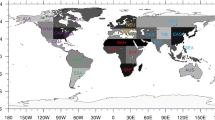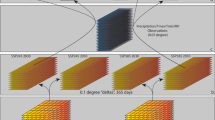Abstract
Uncertainties in the climate response to a doubling of atmospheric CO2 concentrations are quantified in a perturbed land surface parameter experiment. The ensemble of 108 members is constructed by systematically perturbing five poorly constrained land surface parameters of global climate model individually and in all possible combinations. The land surface parameters induce small uncertainties at global scale, substantial uncertainties at regional and seasonal scale and very large uncertainties in the tails of the distribution, the climate extremes. Climate sensitivity varies across the ensemble mainly due to the perturbation of the snow albedo parameterization, which controls the snow albedo feedback strength. The uncertainty range in the global response is small relative to perturbed physics experiments focusing on atmospheric parameters. However, land surface parameters are revealed to control the response not only of the mean but also of the variability of temperature. Major uncertainties are identified in the response of climate extremes to a doubling of CO2. During winter the response both of temperature mean and daily variability relates to fractional snow cover. Cold extremes over high latitudes warm disproportionately in ensemble members with strong snow albedo feedback and large snow cover reduction. Reduced snow cover leads to more winter warming and stronger variability decrease. As a result uncertainties in mean and variability response line up, with some members showing weak and others very strong warming of the cold tail of the distribution, depending on the snow albedo parametrization. The uncertainty across the ensemble regionally exceeds the CMIP3 multi-model range. Regarding summer hot extremes, the uncertainties are larger than for mean summer warming but smaller than in multi-model experiments. The summer precipitation response to a doubling of CO2 is not robust over many regions. Land surface parameter perturbations and natural variability alter the sign of the response even over subtropical regions.












Similar content being viewed by others
References
Alexander L, Zhang X, Peterson T, Caesar J, Gleason B, Tank AK, Haylock M, Collins D, Trewin B, Rahimzadeh F, Tagipour A, Kumar K, Revadekar J, Griffiths G, Vincent L, Stephenson D, Burn J, Aguilar E, Brunet M, Taylor M, New M, Zhai P, Rusticucci M, Vazquez-Aguirre J (2006) Global observed changes in daily climate extremes of temperature and precipitation. J Geophys Res 111. doi:10.1029/2005JD006290
Allen M, Stott P, Mitchell J, Schnur R, Delworth T (2000) Quantifying the uncertainty in forecasts of anthropogenic climate change. Nature 407:617–620
Barnett DN, Brown SJ, Murphy JM, Sexton DMH, Webb MJ (2006) Quantifying uncertainty in changes in extreme event frequency in response to doubled CO2 using a large ensemble of GCM simulations. Clim Dyn 26. doi:10.1007/s00382-005-0097-1
Beniston M (2004) The 2003 heat wave in Europe: a shape of things to come? An analysis based on Swiss climatological data and model simulations. Geophys Res Lett 31. doi:10.1029/2003GL018857
Breiman L, Friedman J, Olshen R, Stone C (1984) Classification and regression trees. Wadsworth, Belmont, CA 1
Burke E and Brown S (2008) Evaluating uncertainties in the projection of future drought. J Hydrometeorol 9:292–299
Caesar J, Alexander L, Vose R (2006) Large-scale changes in observed daily maximum and minimum temperatures: creation and analysis of a new gridded data set. J Geophys Res 111. doi:10.1029/2005JD006280
Clark RT, Brown SJ, Murphy JM (2006) Modeling Northern Hemisphere summer heat extreme changes and their uncertainties using a physics ensemble of climate sensitivity experiments. J Clim 19:4418–4435
Dai A, Trenberth K, and Karl T (1999) Effects of clouds, soil moisture, precipitation, and water vapor on diurnal temperature range. J Clim 12:2451–2473
Easterling D, Evans J, Groisman P, Karl T, Kunkel K, Ambenje P (2000) Observed variability and trends in extreme climate events: a brief review. Bull Am Meteorol Soc 81:417–425
ECMWF (2007) IFS documentation—Cy31r1: part IV, physical processes. ECMWF, Full scientific and technical documentation. http://www.ecmwf.int/research/ifsdocs/CY31r1/index.html
Fischer EM, Schär C (2009) Future changes in daily summer temperature variability: driving processes and role for temperature extremes. Clim Dyn. doi:10.1007/s00382-008-0473-8
Fischer EM, Schär C (2010) Consistent geographical patterns of changes in high-impact european heatwaves. Nat Geosci. doi:10.1038/NGEO866
Frich P, Alexander L, Della-Marta P, Gleason B, Haylock M, Tank A, Peterson T (2002) Observed coherent changes in climatic extremes during the second half of the twentieth century. Clim Res 19:193–212
Gent P, Yeager S, Neale R, Levis S, Bailey D (2010) Improvements in a half degree atmosphere/land version of the CCSM. Clim Dyn 34(6):819–833
Gregory J and Mitchell J (1995) Simulation of daily variability of surface temperature and precipitation over Europe in the current and 2 × CO2 climates using the UKMO climate model. Q J R Meteorol Soc 121:1451–1476
Grize L, Huss A, Thommen O, Schindler C, Braun-Fahrländer C (2005) Heat wave 2003 and mortality in Switzerland. Swiss Med Wkly 135:200–205
Hadley S, Hernandez J, Broniak C, Blasing T (2006) Responses of energy use to climate change: a climate modeling study. Geophys Res Lett 33:L17703
Hawkins E and Sutton R (2009) The potential to narrow uncertainty in regional climate predictions. Bull Am Meteorol Soc 90:1095–1107
Hémon D, Jougla E, Laurent CJF, Bellec S, Pavillon G (2003) Surmortalité liéeàla canicule d’août 2003 en France. Bull Epidémiologique Hebdomadaire 45–46:1–5
IPCC (2007) Climate change 2007: the physical science basis. Contribution of working group i to the fourth assessment report of the intergovernmental panel on climate change. Cambridge University Press, Cambridge, 996 pp
Katz RW and Brown BG (1992) Extreme events in a changing climate: variability is more important than averages. Clim Change 21:289–302
Kharin V, Zwiers F, Zhang X, Hegerl G (2007) Changes in temperature and precipitation extremes in the IPCC ensemble of global coupled model simulations. J Clim 20:1419–1444
Knutti R, Allen M, Friedlingstein P, Gregory J, Hegerl G, Meehl G, Meinshausen M, Murphy J, Plattner G, Raper S et al (2008) A review of uncertainties in global temperature projections over the twenty-first century. J Clim 21:2651–2663
Koster R, Dirmeyer P, Hahmann A, Ijpelaar R, Tyahla L, Cox P, Suarez M (2002) Comparing the degree of land-atmosphere interaction in four atmospheric general circulation models. J Hydrometeor 3:363–375
Kunkel K, Andsager K, Easterling D (1999) Long-term trends in extreme precipitation events over the conterminous United States and Canada. J Clim 12:2515–2527
Lawrence D, Thornton P, Oleson K, Bonan G (2007) The partitioning of evapotranspiration into transpiration, soil evaporation, and canopy evaporation in a GCM: impacts on land-atmosphere interaction. J Hydrometeor 8:862–880
Levis S, Bonan G, Lawrence P (2007) Present-day springtime high-latitude surface albedo as a predictor of simulated climate sensitivity. Geophys Res Lett 34:L17703
Liu Y, Gupta H, Sorooshian S, Bastidas L, Shuttleworth W (2005) Constraining land surface and atmospheric parameters of a locally coupled model using observational data. J Hydrometeor 6:156–172
Meehl G, Covey C, Taylor K, Delworth T, Stouffer R, Latif M, McAvaney B, Mitchell J (2007) The WCRP CMIP3 multimodel dataset:A new era in climate change research. Bull Am Meteorol Soc 88:1383–1394
Meehl G, Zwiers F, Evans J, Knutson T, Mearns L, Whetton P (2000) Trends in extreme weather and climate events: issues related to modeling extremes in projections of future climate change. Bull Am Meteorol Soc 81:427–436
Meehl GA and Tebaldi C (2004) More intense, more frequent, and longer lasting heat waves in the 21st century. Science 305:994–997
Murphy J, Sexton D, Barnett D, Jones G, Webb M, Collins M, Stainforth D (2004) Quantification of modelling uncertainties in a large ensemble of climate change simulations. Nature 430:768–772
Niu G, Yang Z, Dickinson R, Gulden L (2005) A simple TOPMODEL-based runoff parameterization (SIMTOP) for use in global climate models. J Geophys Res 110. doi:10.1029/2005JD006111
Niu G, Yang Z, Dickinson R, Gulden L, Su H (2007) Development of a simple groundwater model for use in climate models and evaluation with Gravity Recovery and Climate Experiment data. J Geophys Res 112. doi:10.1029/2006JD007522
Oleson K, Dai Y, Bonan G, Bosilovich M, Dickinson R, Dirmeyer P, Hoffman F, Houser P, Levis S, Niu G et al (2004) Technical description of the community land model (CLM). Tech Note NCAR/TN-461+ STR
Oleson K, Niu G, Yang Z, Lawrence D, Thornton P, Lawrence P, Stockli R, Dickinson R, Bonan G, Levis S et al (2008) Improvements to the Community Land Model and their impact on the hydrological cycle. J Geophys Res 113. doi:10.1029/2007JG000563
Piani C, Frame D, Stainforth D, Allen M (2005) Constraints on climate change from a multi-thousand member ensemble of simulations. Geophys Res Lett 32:23
Qu X and Hall A (2006) Assessing snow albedo feedback in simulated climate change. J Clim 19:2617–2630
Qu X and Hall A (2007) What controls the strength of snow-albedo feedback? J Clim 34:3971–3981
Räisänen J (2002) CO2-induced changes in interannual temperature and precipitation variability in 19 CMIP2 experiments. J Clim 15:2395–2411
Räisänen J and Joelsson R (2001) Changes in average and extreme precipitation in two regional climate model experiments. Tellus A 53:547–566
Sanderson BM (2010) A multi-model study of parametric uncertainty in predictions of climate response to rising greenhouse gas concentrations. J Clim. doi:10.1175/2010JCLI3498.1
Schär C, Vidale PL, Lüthi D, Frei C, Häberli C, Liniger MA, Appenzeller C (2004) The role of increasing temperature variability in European summer heatwaves. Nature 427:332–336. doi:10.1038/nature02300
Seneviratne SI, Koster RD, Guo Z, Dirmeyer PA, Kowalczyk E, Lawrence D, Liu P, Lu C-H, Mocko D, Oleson KW, Verseghy D (2006a) Soil moisture memory in AGCM simulations: analysis of global land-atmosphere coupling experiment (GLACE) data. J Hydrometeor 7:1090–1112
Seneviratne SI, Lüthi D, Litschi M, Schär C (2006b) Land-atmosphere coupling and climate change in Europe. Nature 443:205–209
Stahl K, Moore R, McKendry I (2006) Climatology of winter cold spells in relation to mountain pine beetle mortality in British Columbia, Canada. Clim Res 32:13–23
Stainforth D, Aina T, Christensen C, Collins M, Faull N, Frame D, Kettleborough J, Knight S, Martin A, Murphy J et al (2005) Uncertainty in predictions of the climate response to rising levels of greenhouse gases. Nature 433:403–406
Steadman RG (1984) A universal scale of apparent temperature. J Clim Appl Meteorol 23:1674–1687
Stöckli R, Lawrence D, Niu G, Oleson K, Thornton P, Yang Z, Bonan G, Denning A, Running S (2008) Use of FLUXNET in the Community Land Model development. J Geophys Res 113. doi:10.1029/2007JG000562
Tebaldi C, Hayhoe K, Arblaster J, and Meehl G (2006) Going to the extremes. Clim Change 79:185–211
Tebaldi C and Knutti R (2007) The use of the multi-model ensemble in probabilistic climate projections. Philos Transact A Math Phys Eng Sci 365:2053
Thornton P and Zimmermann N (2007) An improved canopy integration scheme for a land surface model with prognostic canopy structure. J Clim 20:3902–3923
Vidale PL, Lüthi D, Wegmann R, Schär C (2007) Europea summer climate variability in a heterogeneous multi-model ensemble. Clim Change 81:209–232
Weisheimer A and Palmer T (2005) Changing frequency of occurrence of extreme seasonal temperatures under global warming. Geophys Res Lett 32:L20721
White M, Thornton P, Running S, Ramakrishna R (2000) Parameterization and sensitivity analysis of the BIOME-BGC terrestrial ecosystem model: net primary production controls. Earth Interact 4:1
Acknowledgments
We thank Gerald Meehl, Keith Oleson and Reto Knutti for the fruitful discussion and the anonymous reviewers for their valuable comments on the manuscript. Erich Fischer was supported by the Swiss National Science Foundation. Support of this dataset is provided by the Office of Science, U.S. Department of Energy.
Author information
Authors and Affiliations
Corresponding author
Electronic supplementary material
Below is the link to the electronic supplementary material.
Rights and permissions
About this article
Cite this article
Fischer, E.M., Lawrence, D.M. & Sanderson, B.M. Quantifying uncertainties in projections of extremes—a perturbed land surface parameter experiment. Clim Dyn 37, 1381–1398 (2011). https://doi.org/10.1007/s00382-010-0915-y
Received:
Accepted:
Published:
Issue Date:
DOI: https://doi.org/10.1007/s00382-010-0915-y




